SHIRT is the “Duchampian” rapper recycling art history to make a new statement
Until now, it's been a lifetime of meetings where 'I’m looked at like I have three heads'
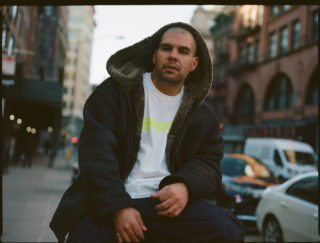
Until now, it's been a lifetime of meetings where 'I’m looked at like I have three heads'
When a hip-hop musician describes his work as “Duchampian” there is, in the space his breath leaves between the end of that sentence and the start of the next, part of your mind that thinks, “Hang on. What?” Such reactions are familiar to New York rapper SHIRT, whose approach to making music is influenced by conceptual visual artists who use found and pre-existing objects in their practice. Artists including Marcel Duchamp – who famously displayed a urinal at an exhibition for the Society of Independent artists in 1917 – and John Baldessari, whose text-on-canvas piece ‘Pure Beauty’ (1968) is the inspiration for SHIRT’s album of the same name, released on Third Man Records in February this year.
“I find a lot that I’m looked at like I have three heads,” SHIRT tells me. “Every time I’ve gone into meetings along the years – or just any kind of situation where I can progress my music – I’ve been talking about it as an art practice. A conceptual art practice. Especially the last couple of years, I’ve been approaching writing songs in a specific way, where I might have, like, a sentence and I’ll go off that sentence. And it’ll start with that sentence, and the song will go off, and it’ll expand. And I’ve been trying to talk about this in terms of an art practice, because I realised a couple of years ago that the way I’ve been writing songs was more conceptual artist than your average rapper. And every time I try to talk to that I’ve been looked at like I have three heads.”
The three heads response was certainly discernable in the reactions to SHIRT’s break out work to date – not a music release, but a fake New York Times article that he wrote about himself in 2014. Using text from articles about other rappers, Shirt put together a profile of himself and published it on a website he had designed as a copy of the New York Times site, posted at a remarkably believable URL (nytimes.la, which has since been taken down) under the by-line of the Times’ go-to hip-hop critic, Jon Caramanica.
The press reported this project as a publicity stunt, describing it variously as either a ‘desperate’ attempt for mainstream attention or a ‘genius’ marketing ploy, mostly overlooking that it was in fact a formal experiment with ideas of appropriation and authorship that have long inflected contemporary art practice, and that continue to shape SHIRT’s own work. For example, in another experiment with appropriation, SHIRT erected a 10-foot high replica of artist Damien Hirst’s ‘Mickey’ in the Queensbridge Housing projects.
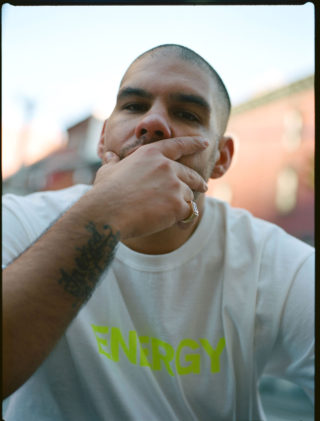
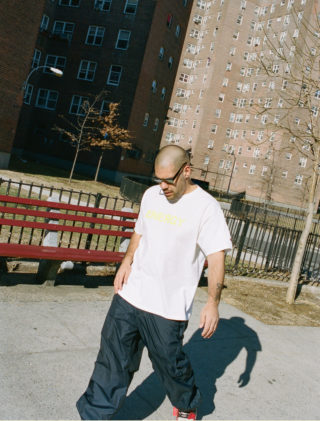
“I had been reading a bunch about this artist named Kenneth Goldsmith who is a professor and a poet and a writer,” SHIRT says, recounting the Times story in that gentle, precise voice, his excitement in the work still tangible almost four years later. “He believes specifically that enough great writing has been done. And we don’t have to do more. It’s about using great past writing to describe new things and not generating new writing. That’s one aspect of what he talks about, and it was really interesting to me. So I had this idea to do a New York Times article where it would be about me, very deeply about me, but using written things about other rappers. So let’s say, articles about Jay Electronica, or certain people where there were paragraphs where you could be describing maybe my music, or my upbringing, or my life.”
The article was tweeted and retweeted by SHIRT’s fans and a mostly baffled music press, who, in the period between its publication and the realisation that it was a fake, couldn’t quite understand why this relatively unknown rapper had a profile on the front page of the Times website. SHIRT shrugs. “It kinda like, blew up.”
One unexpected result of this blow up was that SHIRT formed a connection with Kenneth Goldsmith himself, whose colleagues forwarded the article to him. When he attended a talk by Goldsmith the following year, the artist remembered the article and invited SHIRT to present on his wider body of work to students at the University of Pennsylvania.
“He was teaching an ‘uncreative writing’ class he called it. At Penn University, and he had written all these bestseller books. It was a big deal. And for me to have this much older, amazing man take some sort of interest in what I was doing and tell me that what I was doing, there was a future in it, I need to keep going and all this different stuff, that was an incredible, incredible thing.”
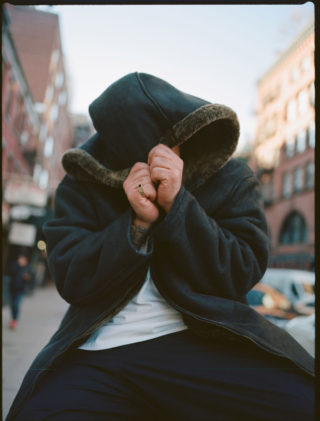
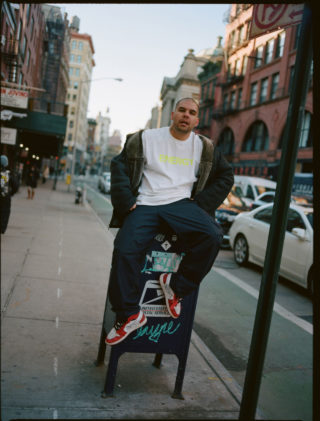
Under Goldsmith’s mentorship, SHIRT – a high school drop out with no experience of undergraduate University education – applied for and was accepted to a Master of Fine Art at a university in Europe, where he has been working on the ‘Pure Beauty’ release. “Me being in school is a huge deal,” he says. “I’m a high school drop out. I never thought in a million years that I would be able to go to a Master of Fine Art or any kind of higher education in that sense. So [Goldsmith] explained to me about this one woman that he knew in this programme and that if I put together a portfolio who knows, maybe I could apply. And that’s what I did. I could put together a great portfolio because I had been working and I had a lot of projects to show and strong sense of what I was doing. And they accepted me. And it really changed my life. You know I was in New York that whole time. My whole life up until then working on my own in a vacuum and this was the first time – I mean to move to another country like this, and be in a program with all international students has just been incredible.”
The Masters program heralded other things too – friendships, an expanded sense of his practice and spiritual rewards. SHIRT describes the sense of poetry he feels in the connections and timing that have led him to this creative place, where he is making his best work. “I been feeling lately like I can really do anything. I have this thing about me, like, ‘we can get this done’. It doesn’t matter how crazy something seems, or how hard it sounds.”
It’s a place where serendipitous meetings continue to lead to good things. On a trip to LA last summer, SHIRT tells me how he visited Baldessari after sending a cold email to his studio, making links with another artist whose support has helped with the evolution of his creativity. “So I found a cold email. Like I found an info@baldessaristudio or something like that. So I cold emailed it. Just a small paragraph about ‘I’m from New York, I’m in Europe right now, I’m in this MA program.’ And they wrote me back right away and said, ‘John would love to meet you.’ And I couldn’t believe it. I was in a café when I got the email and I got tears in my eyes. It was a really big deal for me.
“I came to Baldessari’s work, I guess a couple years ago. Maybe even three or four years ago. There’s a video online that was passing around of an interview that Tom Waits, the musician, narrated. And I found that [Baldessari] had a wit and had an intellect that I was really interested in. I forget exactly what in the video really attracted me, but I started looking at his work and I just became a real fan.
“And he had an artwork from the late ’60s called Pure Beauty. It was a singular work where he wrote ‘Pure Beauty’ across the centre of the canvas. But it was also a larger show – he had other pieces in the show. And in his book were reflections on, like, what’s considered authorship and what’s pure beauty and it’s not necessarily a direct thing. It’s been really interesting in that I’ve had this name for the album for a year. Even before any song was recorded I had this idea, and in my head ‘Pure Beauty’ represented that maybe the purest beauty is almost ugly. Or maybe what we’ve come to consider ugly is actually beauty at its purest form. And that’s something I was playing with a lot. And just the implications of that, like you know, turning something on its head. Something that maybe was negative into something positive. It’s as simple as that maybe.”
Shortly after their meeting, Baldessari agreed to allow SHIRT a license to use the ‘Pure Beauty’ image for the vinyl album artwork. “The entire album packaging as far as the vinyl is concerned is original Baldessari works. And my thing is not changing anything – it’s literally the cover. You know many people they take visual cues and they change it slightly, they change the words. My thing is I come from the Duchampian – I’m a student of Marcel Duchamp. So it’s very much using things that have already existed and bringing them into new light and new energy.”
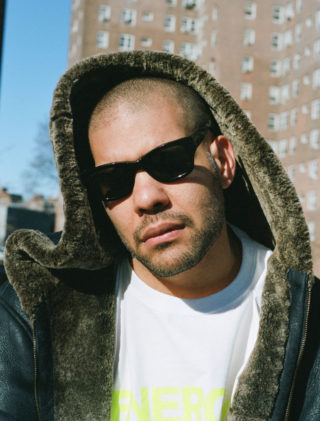
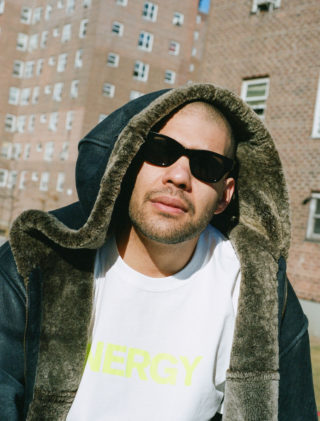
The serendipity, the perfect – perhaps fated – evolution of the album continued with Shirt’s signing to Third Man, an unexpected twist of events that happened the night before ‘Pure Beauty’’s planned independent release. After years of disappointing meetings with companies who didn’t quite get his approach (or who loved the work but weren’t quite convinced enough to partner up) SHIRT had resigned himself, more or less happily, to the life of an independent artist, creating pop-up works across Europe, LA and New York, and sharing them on social media, while releasing his own music, often offering downloads for free.
“In my mind I was like [‘Pure Beauty’] is just another project I’m going to release on my own. And I’m not new to that, so I decided that I wanted it on iTunes and all this different stuff. That it would be available on streaming services. There’s ways for independent artists to make that happen.”
It was all in place, and then, out of the blue, the night before he dropped the record, “A kid that works at Third Man reached out. And they said that they’ve been watching me for the last year and can we get on the phone? And this was literally the night before the album was supposed to come out. So I decided very quickly to respect the talk. Meaning like, not just look at this as something else. I look at things very much as poetic, sometimes. Especially the timing of things. It’s like poetry to me in a sense. And so when they reached out the night before it was like a special thing. We got on the phone, we spoke. And for the first time in my life, the first time, I was speaking to these music business people, they don’t make art, they represent like Jack [White] and Margo [Price] and real musicians. But they were saying things that I’ve never heard before. I was finally talking to them about who I am and what I love and what inspires me. And they were saying things back that I really had never heard from music business people. I really… I felt like it was something special. So the next day I sent an emergency email to these streaming services and I pulled the album down. I decided to wait to see what would happen. And over the next few weeks we got a deal done and they decided they wanted to release the record.”
Not only that, but they signed him for a two album deal, and agreed he could release ‘Pure Beauty’ exactly as he had already created it, exactly as he wanted it, without production interference. “So the record that’s out is untouched.” Shirt says. “This is the record, the pure and raw record that I made on my own.”